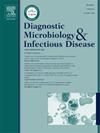Validated cost-effective casein-based blocking buffers for enhanced neurocysticercosis ELISA accuracy
IF 1.8
4区 医学
Q3 INFECTIOUS DISEASES
Diagnostic microbiology and infectious disease
Pub Date : 2025-07-29
DOI:10.1016/j.diagmicrobio.2025.117033
引用次数: 0
Abstract
Accurate and affordable diagnostic tools are essential for managing neurocysticercosis, a parasitic infection of the central nervous system. In indirect ELISA, blocking buffers are crucial to prevent background noise and ensure reliable results, yet few studies have compared their performance in this specific context. This study assessed nine blocking solutions, four commercial and five prepared in-Lab, using an indirect ELISA with crude Cysticercus cellulosae antigen and a panel of 30 human serum samples (14 positive, 16 negative). By keeping all other variables constant, isolated the impact of each blocking buffer on test performance. Six formulations achieved perfect diagnostic accuracy (100 % sensitivity and specificity), while the remaining three ranged from 84.6 to 93.7 % sensitivity. ROC curve analysis confirmed high overall performance (AUC 0.957–1.000). Notably, a 3 % casein-based in-Lab blocker (B9) delivered the best results, offering strong analytical consistency, flawless diagnostic metrics, and a cost reduction of over 90 % compared to commercial alternatives. Despite the limited sample size, these findings demonstrate that well-prepared in-Lab blocking buffers, particularly those based on casein, can match or exceed commercial reagents in iELISA performance while drastically lowering costs. This approach has strong potential for expanding access to accurate NCC diagnostics in resource-limited settings.
经验证具有成本效益的基于酪蛋白的阻断缓冲液可提高神经囊虫ELISA的准确性
准确和负担得起的诊断工具对于治疗中枢神经系统寄生虫感染的神经囊虫病至关重要。在间接ELISA中,阻断缓冲液对于防止背景噪声和确保可靠的结果至关重要,但很少有研究比较它们在这种特定情况下的性能。本研究评估了9种阻断溶液,其中4种是商业化的,5种是实验室制备的,使用的是含纤维素囊尾蚴粗抗原的间接ELISA和30份人血清样本(14份阳性,16份阴性)。通过保持所有其他变量不变,隔离了每个阻塞缓冲区对测试性能的影响。6个配方获得了完美的诊断准确性(100%的灵敏度和特异性),而其余3个的灵敏度范围为84.6 - 93.7%。ROC曲线分析证实整体表现良好(AUC 0.957-1.000)。值得注意的是,基于3%酪蛋白的实验室阻断剂(B9)提供了最好的结果,提供了强大的分析一致性,完美的诊断指标,与商业替代品相比,成本降低了90%以上。尽管样本量有限,但这些研究结果表明,精心制备的实验室阻断缓冲液,特别是那些基于酪蛋白的缓冲液,在iELISA性能上可以匹配或超过商业试剂,同时大幅降低成本。在资源有限的情况下,这种方法具有扩大获得准确的NCC诊断的巨大潜力。
本文章由计算机程序翻译,如有差异,请以英文原文为准。
求助全文
约1分钟内获得全文
求助全文
来源期刊
CiteScore
5.30
自引率
3.40%
发文量
149
审稿时长
56 days
期刊介绍:
Diagnostic Microbiology and Infectious Disease keeps you informed of the latest developments in clinical microbiology and the diagnosis and treatment of infectious diseases. Packed with rigorously peer-reviewed articles and studies in bacteriology, immunology, immunoserology, infectious diseases, mycology, parasitology, and virology, the journal examines new procedures, unusual cases, controversial issues, and important new literature. Diagnostic Microbiology and Infectious Disease distinguished independent editorial board, consisting of experts from many medical specialties, ensures you extensive and authoritative coverage.

 求助内容:
求助内容: 应助结果提醒方式:
应助结果提醒方式:


